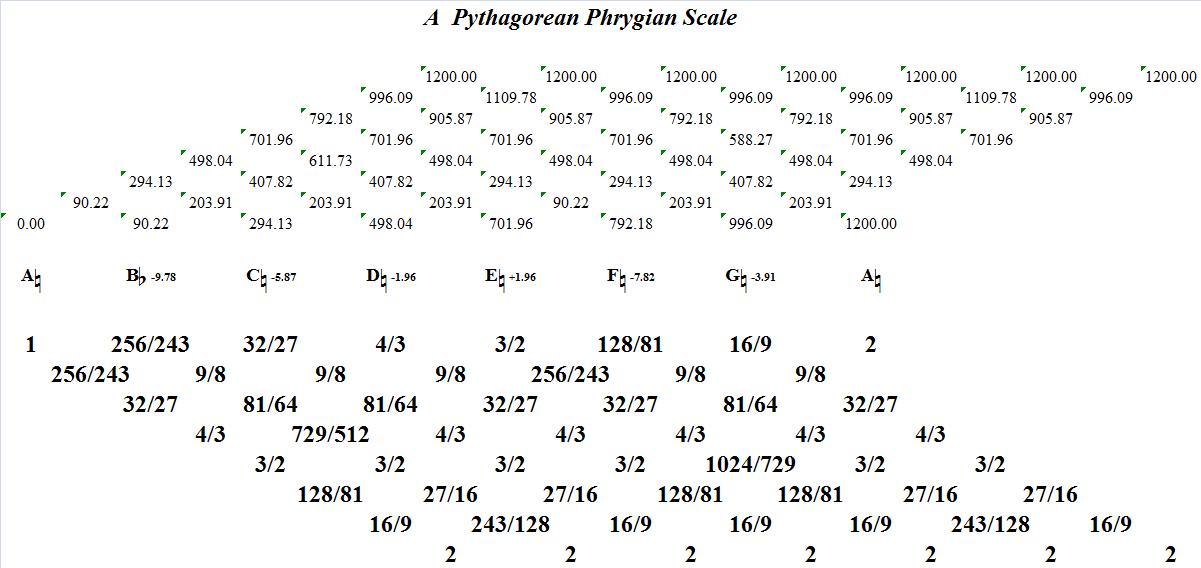
The intervallic content of the A Pythagorean Phrygian Scale.
 Kenny Dorham: Quiet Kenny. 1959 (re-released in 1992). Prestige/New Jazz Records: OJCCD-250-2.
Kenny Dorham: Quiet Kenny. 1959 (re-released in 1992). Prestige/New Jazz Records: OJCCD-250-2. Reuben Radding: Fugitive Pieces. 2006. Pine Ear Music: PEM 002.
Reuben Radding: Fugitive Pieces. 2006. Pine Ear Music: PEM 002. Jim Black: Alasnoaxis. 2000. Winter & Winter: 910061-2.
Jim Black: Alasnoaxis. 2000. Winter & Winter: 910061-2. Marilyn Crispell/Gerry Hemingway @ An Die Musik, Baltimore, MD
Marilyn Crispell/Gerry Hemingway @ An Die Musik, Baltimore, MD
 Wolf Eyes & Anthony Braxton: Black Vomit. 2006. Victo: cd 099.
Wolf Eyes & Anthony Braxton: Black Vomit. 2006. Victo: cd 099. William Parker Double Quartet: Alphaville Suite: Music Inspired by the Jean Luc Godard Film. 2007. Rogue Art: ROG 0010.
William Parker Double Quartet: Alphaville Suite: Music Inspired by the Jean Luc Godard Film. 2007. Rogue Art: ROG 0010. Arrington de Dionyso/Gust Burns: Ataque Holotropical. 2006. CD-R produced by Arrington de Dionyso.
Arrington de Dionyso/Gust Burns: Ataque Holotropical. 2006. CD-R produced by Arrington de Dionyso. March 9, 2009
March 9, 2009
 Curlew: Gussie. 2003. Roaratorio: Roar 05.
Curlew: Gussie. 2003. Roaratorio: Roar 05. Don Byron: Romance With The Unseen. 1999. Blue Note Records: 7243 4 99545 2 6.
Don Byron: Romance With The Unseen. 1999. Blue Note Records: 7243 4 99545 2 6. Albert Ayler: New Grass. 1968 (re-released in 2005). Impulse: A-9175.
Albert Ayler: New Grass. 1968 (re-released in 2005). Impulse: A-9175. Modern Masters @ An Die Musik, Baltimore, MD
Modern Masters @ An Die Musik, Baltimore, MD Mobtown Modern: Sequenzathon (almost) the complete Seqenzas (1958 - 2002) @ The Contemporary Museum, Baltimore, MD
Mobtown Modern: Sequenzathon (almost) the complete Seqenzas (1958 - 2002) @ The Contemporary Museum, Baltimore, MD Ludwig van Beethoven: The Symphonies [disc 5]. Recorded in 1994. The International Music Company: 205299-305.
Ludwig van Beethoven: The Symphonies [disc 5]. Recorded in 1994. The International Music Company: 205299-305. Ludwig van Beethoven: The Complete Quartets, Vol. IV. Recorded in 1986. Delos: DE 3034.
Ludwig van Beethoven: The Complete Quartets, Vol. IV. Recorded in 1986. Delos: DE 3034. Albert Ayler: Holy Ghost (box set) [disc 3]. 2004. Revenant Records: 213.
Albert Ayler: Holy Ghost (box set) [disc 3]. 2004. Revenant Records: 213. Cache-Flow Quartet/Instant Coffee @ The Red Room, Baltimore, MD
Cache-Flow Quartet/Instant Coffee @ The Red Room, Baltimore, MD ecoming unhinged from the collaborative sound of the group. These three different personalities and musical histories finding a common territory of evolving textures. Instant Coffee has a good sound that keeps the ears steeped in its unexpected turns.
ecoming unhinged from the collaborative sound of the group. These three different personalities and musical histories finding a common territory of evolving textures. Instant Coffee has a good sound that keeps the ears steeped in its unexpected turns.